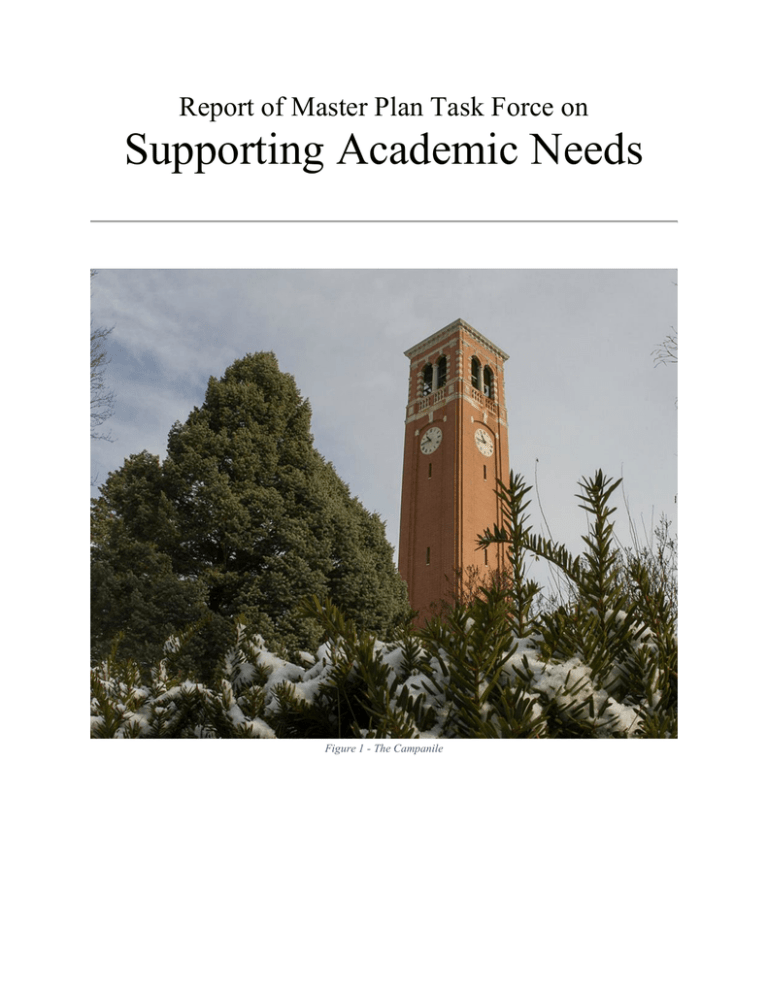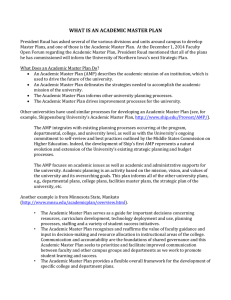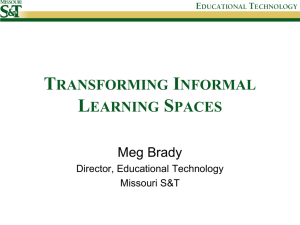Supporting Academic Needs Report of Master Plan Task Force on
advertisement

Report of Master Plan Task Force on Supporting Academic Needs Figure 1 - The Campanile Report of the Master Plan Task Force on Supporting Academic Needs 2015 April Membership and Objectives Celeste Bembry, Recruitment and Retention Coordinator, CHAS Nancy Cobb, Associate Provost for Faculty Affairs Belle Cowden, Continuing Education Blake Findley, Student Suzanne Freedman, Professor of Educational Psychology and Foundations Andy Gilpin, Professor of Psychology Chad Heinzel, Associate Professor of Earth Sciences Terry Hogan, Vice President for Student Affairs Mary Mark, Chief Information Officer Susan Moore, Associate Professor, Rod Library Scott Peters, Associate Professor of Political Science The Task Force on Supporting Academic Needs was formed to address community partnership issues associated with the University of Northern Iowa (UNI) campus. It was asked to consider such questions as: • • • • • What are the types of facilities that will support robust teaching and learning on a 21st Century campus? How can the campus master plan foster good stewardship and accommodate students over the next 5, 10 and 20 years? What are the important space planning and utilization considerations that will ensure the continued provision of top quality educational services? How can space be changed, modified or built that will better utilize and maximize UNI’s building resources? What types of partnerships can be forged between academic units to better serve students, faculty and staff as well as the community of Cedar Falls, and the citizens of Iowa? Background The Task Force on Supporting Academic Needs focused on the academic needs of the university. The Task Force viewed itself as the link between the Facilities Master Plan process and the ongoing Academic Master Plan process. In carrying out the work of the Task Force, the committee interviewed all six of UNI’s deans; the discussions with the deans sometimes included associate deans or other faculty members. The Task Force also interviewed the leaders of Business and Community Services (BCS) and the Center for Energy and Environmental Education (CEEE). During the course of the spring semester, the chair of the Task Force on Supporting Academic Needs also attended a meeting with the Task Force on Creating a Sustainable Campus and met with the chairs of all the task forces several times to discuss common interests and findings. The Task Force’s central challenge in linking the Facilities Master Plan (FMP) to the Academic Master Plan (AMP) is the different timelines under which both planning processes are operating. The AMP is to serve as the strategic backbone of the university’s planning, but the first draft of the AMP is not set to be circulated widely until April 2016. Further, Board of Regents will be engaging in its own strategic planning process next year; the AMP may need to be adjusted accordingly. The Board’s plan and the AMP will define the core strategic choices UNI makes in the coming years. The FMP must be able to help implement those strategic priorities, once identified. Accordingly, the committee divides its findings into three categories: 1) general findings regarding space needs and usage that are largely independent of the university’s academic priorities; 2) specific findings of strategic opportunities that should be referred to the AMP Steering Committee for further discussion; and, 3) strategic themes that should guide the FMP’s implementation of AMP strategic goals. The committee also issue several recommendations aimed at exploring ideas generated during the process of implementing the FMP. Findings: Space Needs and Usage Supporting Academic Needs Page 2|5 ● ● ● ● ● ● Teaching and research spaces ○ Faculty are increasingly hampered by lack of flexibility in classroom spaces. In several buildings (Curris Business Building [CBB], Seerley Hall [SRL], Lang Hall), tiered classrooms with fixed seats force faculty to lecture and constrain their ability to engage in other types of pedagogy. Some of these classrooms cannot be cost-effectively remodeled to eliminate the tiered seating. ○ UNI has seen a decline in demand for large lecture spaces. Many of UNI’s larger lecture halls are underutilized; indeed, the renovation plans for Schindler Education Center eliminate the large lecture halls. Still, it is important to keep in mind for future planning that the university needs large spaces for public events, such as conferences or public lectures. There are some spaces on campus (e.g., CEEE) that are appropriate for such events and which are under-utilized for that purpose. ○ Some colleges, particularly College of Humanities, Arts and Sciences (CHAS), have too few rooms available in the 25-40 student range. ○ Even as the committee stresses flexibility, the continued need in many programs for specialized spaces (e.g., labs, studios, private, confidential) must also be remembered. Such spaces are essential for program health and growth. Academic programs across campus have storage needs that are not being met. Many academic programs would benefit from spaces in which they can more easily interact with community partners. The campus is not always accessible to the public, and UNI has a number of programs that interact with members of the public or with business or community partners. The experience of BCS and CEEE demonstrates the advantages of spaces that have easy access to parking and are more easily accessible than buildings at the center of campus. Faculty would benefit from standardized technology in classrooms. Figure 2 - Business and Community Services (BCS) Many programs have needs for increased spaces for their student organizations. UNI has a number of academic programs on campus that engage in clinical work with the public. (For example, educational psychology, counseling, gerontology, social work, psychology, and communications disorders). In many cases, their space needs are similar. Findings: Academic Opportunities for Discussion by Academic Master Plan Steering Committee In the course of the committee’s discussions and those of other task forces, many interesting ideas were generated. The Task Force thinks that the ideas below are worth discussion by the AMP Steering Committee and/or relevant academic programs. ● Possible new programs ○ New program in field of tourism development / hospitality management that could partner with a hotel near campus. There would be potential here for forming a 2+2 with Kirkwood’s hospitality management program. ○ Interdisciplinary program between industrial technology and art. ○ Interdisciplinary program between real estate, interior design and construction management. ● Given the wide range of sustainability efforts on campus, there is an opportunity to integrate more thoroughly these efforts throughout the curriculum. Supporting Academic Needs Page 3|5 ● ● UNI has beautiful grounds and exciting things happening outdoors. Some of these (e.g., community garden) are already being incorporated into teaching and learning. But are there other ways to expand the idea of the classroom to include the grounds? This might include something as simple as encouraging faculty to think about ways to incorporate the trail system into appropriate courses, but it could also be broader, such as the development of outdoor classrooms that could be used regularly. ● The College of Business Administration floated the idea of raising corporate sponsorship to construct a model Figure 3 - The Panther Plot, an On-Campus Vegetable Garden. trading classroom for the finance program. Along these lines, are there ways to create and / or increase the visibility of interesting teaching and learning spaces? Such spaces could be helpful in recruitment. The creation of an academic incubator. In order to promote interdisciplinary ventures, the campus could borrow the model of the business incubator. UNI could create a space that would put interested parties together for a key period of time to plan and start new programs. Along these same lines, the creation of a true faculty lounge may facilitate serendipity and encourage more faculty interaction and creativity. Findings: Strategic Themes in Merging Facilities Master Plan and Academic Master Plan ● ● ● ● ● ● ● Consideration of academic goals should include a more thorough and regular consideration of space needs, constraints and desires. The academic goals of the campus are often linked to space in ways that are not immediately realized. Sometimes program growth may require new or updated spaces. Other times, the nature of the space my limit pedagogical options of the university. Interdisciplinary programs present long-term space challenges and opportunities. Interdisciplinary programs, particularly those that span multiple colleges, often lack a true “home” in which their faculty members and students can congregate, share ideas and establish a sense of identity and community. This may make it more difficult to sustain these programs long-term. Conversely, the current fiscal climate seems to favor building projects that have a sense of excitement, creativity and vision, which interdisciplinary programs often have. Construction of new spaces for such programs could free up existing spaces for growth in other areas. The FMP should facilitate academic programs’ ability to establish, maintain and enhance on- and offcampus partnerships. The FMP must carefully consider the implications of the AMP’s goals re: online and hybrid education. Changes in the use of technology may require changes to demands for classrooms. For example, if the use of hybrid classes increases, classroom demand will decrease. The FMP must be able to accommodate and should encourage the ability to use all of campus — the grounds as well as the buildings — as part of the learning environment. These efforts will also help to make campus more welcoming and well-integrated with the surrounding community. Wherever possible, the FMP should seek to further the goals of academic programs by engaging students in the process of planning, renovation and design. UNI has a number of academic programs of which students would benefit from such hands-on experience (e.g., interior design, construction management, history and signage on significance of buildings, geography and drone surveys, transportation studies, environmental sciences, and sustainability efforts). The FMP should encourage spaces to be renovated in ways that are as flexible as possible and allow for alteration in the future as pedagogies and technologies change. Availability of space designed for planned periodic reassignment would also provide more flexibility when remodeling of existing buildings requires temporary relocation of faculty and staff during the process. Recommendations Supporting Academic Needs Page 4|5 ● ● ● Given the potential for cooperation among programs, more efficient use of space, and improved community interactions, the Provost and deans should encourage a conversation among departments / programs that would be able to share a common, more easily accessible clinical space. Regular reviews of academic programs should encourage strategic consideration of space needs and opportunities, including interdisciplinary and community partnership opportunities. The university must seek ways to provide a supportive forum for the continuous planning processes. The planning processes should include meaningful participation by students. After the AMP is finalized, Facilities Planning department should convene a faculty group to explicitly link the FMP to the AMP. Their conversations should begin with the findings above. Supporting Academic Needs Page 5|5

